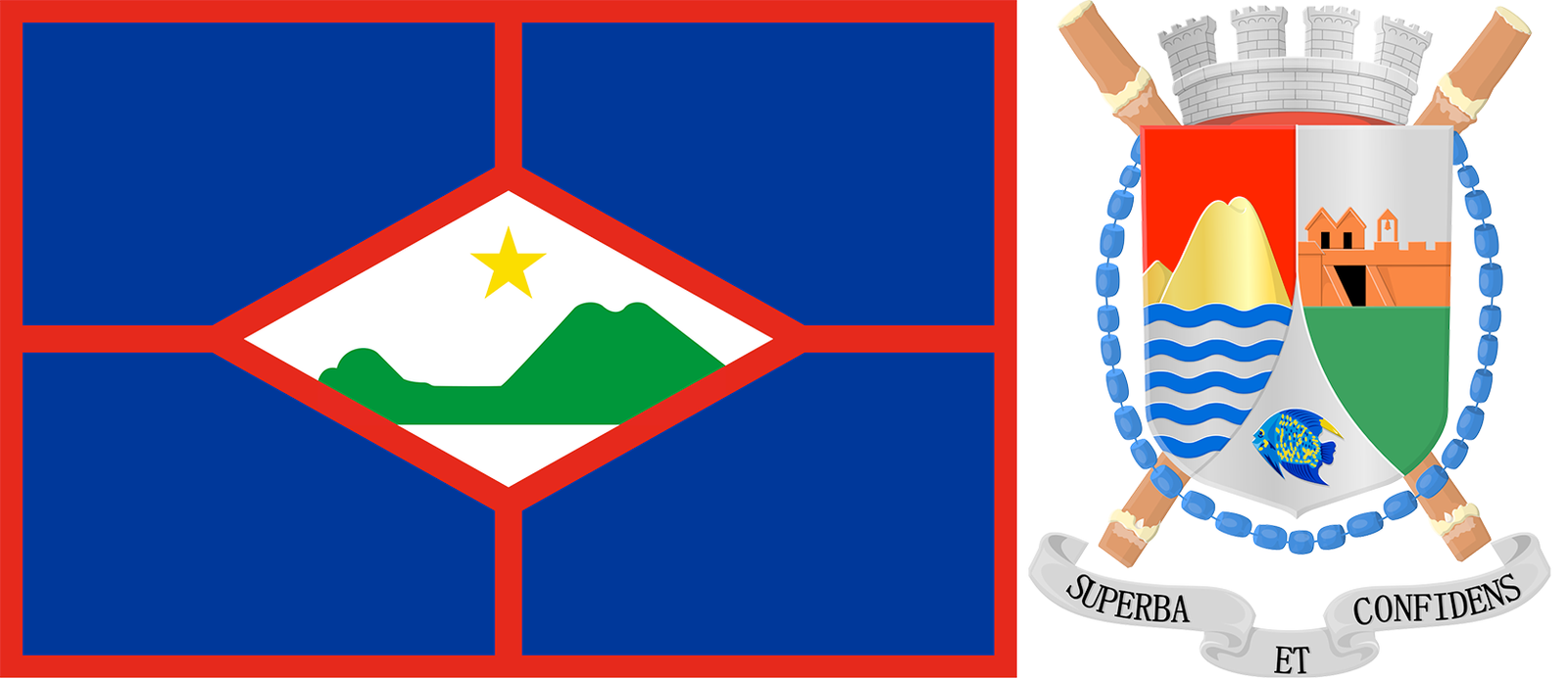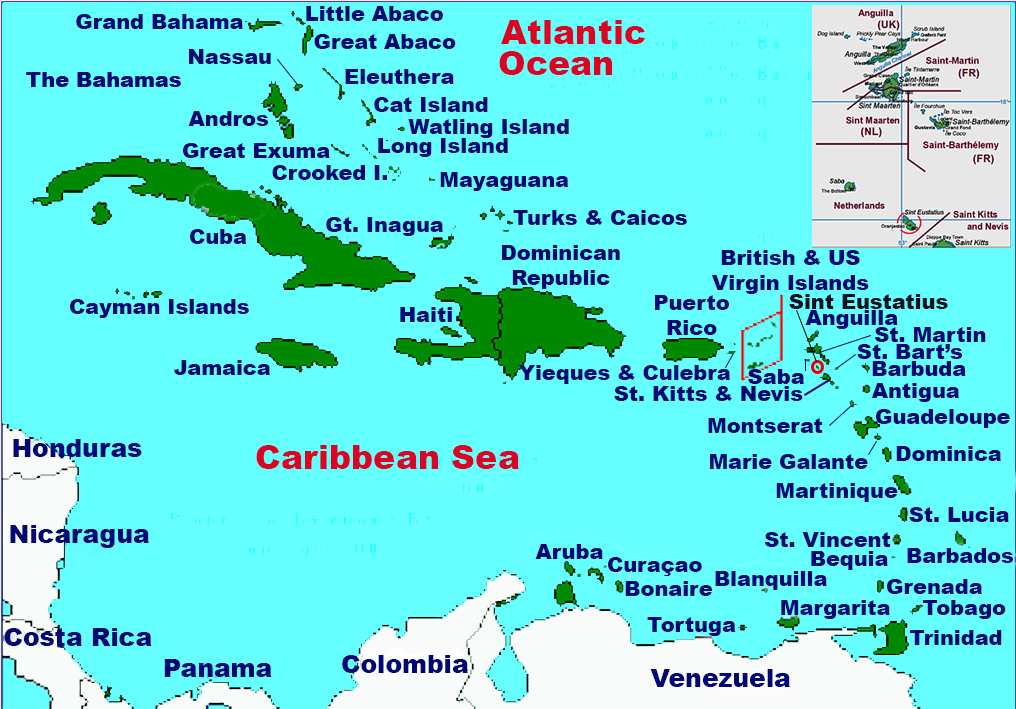FabulousFusionFood's Sint Eustatian Recipes Home Page
 The flag of Sint Eustatius (left) and the coat of
The flag of Sint Eustatius (left) and the coat ofarms of Sint Eustatius (right).
Welcome to the summary page for FabulousFusionFood's Sint Eustatian recipes, part of the Caribbean. This page provides links to all the Curaçao recipes presented on this site, with 12 recipes in total.
This is a continuation of an entire series of pages that will, I hope, allow my visitors to better navigate this site. As well as displaying recipes by name, country and region of origin I am now planning a whole series of pages where recipes can be located by meal type and main ingredient. This page gives a listing of all the Sint Eustatian recipes added to this site.
Sint Eustatius, known locally as Statia, is an island in the Caribbean. It is a special municipality (officially "public body") of the Netherlands. Its capital and largest city is Oranjestad. English and Dutch are the official languages and the demonyms are St. Eustatian and Statian.
Sint Eustatius' cuisine is a unique blend of local, Dutch, and Caribbean influences, reflecting the island's diverse history and cultural heritage. Traditional dishes and eating habits on St. Eustatius are characterized by a strong focus on fresh ingredients, seafood, and local produce.
Sint Eustatius known locally as Statia, is an island in the Caribbean. It is a special municipality (officially 'public body') of the Netherlands. The island lies in the northern Leeward Islands, southeast of the Virgin Islands. Sint Eustatius is immediately to the northwest of Saint Kitts and southeast of Saba. The regional capital is Oranjestad. The island has an area of 21 square kilometres (8.1 sq mi). Travellers to the island by air arrive through F.D. Roosevelt Airport.
 Image of the Caribbean with the location of Saba picked out
Image of the Caribbean with the location of Saba picked out
and circled, a blow-up map of Sint Eustatius in relation to Saba and Sint Maarten is show, inset.Formerly part of the Netherlands Antilles, Sint Eustatius became a public body of the Netherlands in 2010. It is part of the Dutch Caribbean, which consists of Aruba, Bonaire, Curaçao, Saba, Sint Eustatius, and Sint Maarten. Together with Bonaire and Saba, it forms the BES Islands, also referred to as the Caribbean Netherlands. Along with Saba and Sint Maarten it also forms part of the SSS islands.
Sint Eustatius played a major role in the American War for Independence, supplying American insurgents with war materiel, especially gunpowder. The British captured St. Eustatius, which was a major blow to the U.S. and its European allies. The French navy later in the war recaptured the island.
Etymology: The island's name, Sint Eustatius, is Dutch for Saint Eustace (also spelled Eustachius or Eustathius), a legendary Christian martyr, known in Spanish as San Eustaquio and in Portuguese as Santo Eustáquio or Santo Eustácio.
The island's prior Dutch name was Nieuw Zeeland ('New Zeeland''), named by the Zeelanders who settled there in the 1630s.[13][14] It was renamed Sint Eustatius shortly thereafter. The indigenous name for the island is Aloi meaning 'cashew island' (origin Arawak).
Sint Eustatius' cuisine is a unique blend of local, Dutch, and Caribbean influences, reflecting the island's diverse history and cultural heritage. Traditional dishes and eating habits on St. Eustatius are characterized by a strong focus on fresh ingredients, seafood, and local produce.. The national dish is goat meat, rice and peas with local ground provisions (provisions are typically starch root vegetables but also include plantains, green bananas and breadfruit).
Statians typically enjoy three main meals throughout the day - breakfast, lunch, and dinner. Breakfast often consists of simple fare like bread, fruit, or porridge, while lunch and dinner are more substantial meals featuring rice, meat, or fish. The island's tropical climate ensures a wide variety of fruits and vegetables are available year-round, which are often incorporated into meals.
Typical dishes would include goat water, conch and dumplings, Johnny cakes, funchi, pastechi and coconut pie. Sint Eustatius shares many dishes in common with Aruba, Curacao, Saba and Sint Maarten as well as Suriname.
This is a continuation of an entire series of pages that will, I hope, allow my visitors to better navigate this site. As well as displaying recipes by name, country and region of origin I am now planning a whole series of pages where recipes can be located by meal type and main ingredient. This page gives a listing of all the Sint Eustatian recipes added to this site.
Sint Eustatius, known locally as Statia, is an island in the Caribbean. It is a special municipality (officially "public body") of the Netherlands. Its capital and largest city is Oranjestad. English and Dutch are the official languages and the demonyms are St. Eustatian and Statian.
Sint Eustatius' cuisine is a unique blend of local, Dutch, and Caribbean influences, reflecting the island's diverse history and cultural heritage. Traditional dishes and eating habits on St. Eustatius are characterized by a strong focus on fresh ingredients, seafood, and local produce.
Sint Eustatius known locally as Statia, is an island in the Caribbean. It is a special municipality (officially 'public body') of the Netherlands. The island lies in the northern Leeward Islands, southeast of the Virgin Islands. Sint Eustatius is immediately to the northwest of Saint Kitts and southeast of Saba. The regional capital is Oranjestad. The island has an area of 21 square kilometres (8.1 sq mi). Travellers to the island by air arrive through F.D. Roosevelt Airport.
 Image of the Caribbean with the location of Saba picked out
Image of the Caribbean with the location of Saba picked outand circled, a blow-up map of Sint Eustatius in relation to Saba and Sint Maarten is show, inset.
Sint Eustatius played a major role in the American War for Independence, supplying American insurgents with war materiel, especially gunpowder. The British captured St. Eustatius, which was a major blow to the U.S. and its European allies. The French navy later in the war recaptured the island.
Etymology: The island's name, Sint Eustatius, is Dutch for Saint Eustace (also spelled Eustachius or Eustathius), a legendary Christian martyr, known in Spanish as San Eustaquio and in Portuguese as Santo Eustáquio or Santo Eustácio.
The island's prior Dutch name was Nieuw Zeeland ('New Zeeland''), named by the Zeelanders who settled there in the 1630s.[13][14] It was renamed Sint Eustatius shortly thereafter. The indigenous name for the island is Aloi meaning 'cashew island' (origin Arawak).
Sint Eustatian Cuisine:
Local food is called Krioyo (pronounced the same as criollo, the Spanish word for 'Creole') and boasts a blend of flavours and techniques best compared to Caribbean cuisine and Latin American cuisine. Dishes common in Curaçao are found in Aruba and Bonaire as well. Popular dishes include stobá (a stew made with various ingredients such as papaya, beef or goat), Guiambo (soup made from okra and seafood), kadushi (cactus soup), sopi mondongo (intestine soup), funchi (cornmeal paste similar to fufu, ugali and polenta) and fish and other seafood. The ubiquitous side dish is fried plantain. Local bread rolls are made according to a Portuguese recipe. All around the island, there are snèks which serve local dishes as well as alcoholic drinks in a manner akin to the English pub.Sint Eustatius' cuisine is a unique blend of local, Dutch, and Caribbean influences, reflecting the island's diverse history and cultural heritage. Traditional dishes and eating habits on St. Eustatius are characterized by a strong focus on fresh ingredients, seafood, and local produce.. The national dish is goat meat, rice and peas with local ground provisions (provisions are typically starch root vegetables but also include plantains, green bananas and breadfruit).
Statians typically enjoy three main meals throughout the day - breakfast, lunch, and dinner. Breakfast often consists of simple fare like bread, fruit, or porridge, while lunch and dinner are more substantial meals featuring rice, meat, or fish. The island's tropical climate ensures a wide variety of fruits and vegetables are available year-round, which are often incorporated into meals.
Typical dishes would include goat water, conch and dumplings, Johnny cakes, funchi, pastechi and coconut pie. Sint Eustatius shares many dishes in common with Aruba, Curacao, Saba and Sint Maarten as well as Suriname.
The alphabetical list of all the Sint Eustatian recipes on this site follows, (limited to 100 recipes per page). There are 12 recipes in total:
Page 1 of 1
| Bolo Pretu (Sint Eustatian Black Cake) Origin: Sint Eustatius | Karni Stobá (Sint Eustatian Stewed Beef) Origin: Sint Eustatius | Sint Eustatian Goat Water Origin: Sint Eustatius |
| Cheese Pastechi Origin: Sint Eustatius | Kokos Taart (Coconut Tart) Origin: Sint Eustatius | Sint Eustatian Johnny Cakes Origin: Sint Eustatian |
| Funchi Origin: Sint Eustatius | Pan Bati Origin: Sint Eustatius | Sint Eustatius Pastechi di Karni (Meat Pastechi) Origin: Sint Eustatius |
| Grilled Red Snapper Origin: Sint Eustatius | Seafood Pastechi Origin: Sint Eustatius | Sint Eustatius Rice and Black Beans Origin: Sint Eustatius |
Page 1 of 1